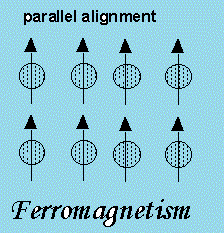
A ferromagnetic material heated above its Curie temperature. Which one is the correct statement?
A. Ferromagnetic domains are perfectly arranged
B. Ferromagnetic domains become random
C. Ferromagnetic domains are not influenced
D. Ferromagnetic material changes into diamagnetic material
Answer
588.6k+ views
Hint: When we heat some element, molecules inside it get thermal energy and start to move here and there. This same thing happens with magnetic materials too, increasing the temperature makes the domains inside it chaotic, which reduces the magnetic strength.
Complete step by step answer:
To know the effect of temperature on ferromagnetic material we have to know what ferromagnetic materials are.
Ferromagnetic Material: Ferromagnetic materials are those which get strongly magnetised when placed in an external magnetic field. They have a strong tendency to move from weak magnetic field to strong magnetic field.
In simple language, these types of material get strongly attracted to a magnet.
Examples of ferromagnetic materials are: Iron, Cobalt, nickel, gadolinium, etc.
Let us see the structure of ferromagnetic material,
Individual atoms (or ions or molecules) in a ferromagnetic material possess a dipole moment. However these atoms arranged themselves in a common direction over a macroscopic volume called domains. When we place ferromagnetic materials in the external magnetic field. The domain gets aligned in the direction of the magnetic field. And when we remove the external magnetic field, the domains are still aligned in the same direction. This is only observed under a microscope.

Effect of temperature on ferromagnetic material
The ferromagnetic material depends on temperature. At high temperature, a ferromagnetic material becomes paramagnetic material. The domain structure disintegrates with temperature.
The temperature of transition from ferromagnetic material to paramagnetic material is known as Curie temperature ${{T}_{c}}$ .
Answer is option B. Ferromagnetic domains become random.
Additional Information:
Curie temperature of some ferromagnetic materials are below, so that you get an Idea of Curie temperature.
Cobalt - 1394 K
Iron - 1043 K
Nickel – 631 K
Note: There is a term magnetic susceptibility which shows how easily the substance can get magnetised when placed in the magnetising field. Therefore when the temperature gradually increases then its magnetic susceptibility decreases and at a stage the substance changes into paramagnetic.
Complete step by step answer:
To know the effect of temperature on ferromagnetic material we have to know what ferromagnetic materials are.
Ferromagnetic Material: Ferromagnetic materials are those which get strongly magnetised when placed in an external magnetic field. They have a strong tendency to move from weak magnetic field to strong magnetic field.
In simple language, these types of material get strongly attracted to a magnet.
Examples of ferromagnetic materials are: Iron, Cobalt, nickel, gadolinium, etc.
Let us see the structure of ferromagnetic material,
Individual atoms (or ions or molecules) in a ferromagnetic material possess a dipole moment. However these atoms arranged themselves in a common direction over a macroscopic volume called domains. When we place ferromagnetic materials in the external magnetic field. The domain gets aligned in the direction of the magnetic field. And when we remove the external magnetic field, the domains are still aligned in the same direction. This is only observed under a microscope.

Effect of temperature on ferromagnetic material
The ferromagnetic material depends on temperature. At high temperature, a ferromagnetic material becomes paramagnetic material. The domain structure disintegrates with temperature.
The temperature of transition from ferromagnetic material to paramagnetic material is known as Curie temperature ${{T}_{c}}$ .
Answer is option B. Ferromagnetic domains become random.
Additional Information:
Curie temperature of some ferromagnetic materials are below, so that you get an Idea of Curie temperature.
Cobalt - 1394 K
Iron - 1043 K
Nickel – 631 K
Note: There is a term magnetic susceptibility which shows how easily the substance can get magnetised when placed in the magnetising field. Therefore when the temperature gradually increases then its magnetic susceptibility decreases and at a stage the substance changes into paramagnetic.
Recently Updated Pages
Why are manures considered better than fertilizers class 11 biology CBSE

Find the coordinates of the midpoint of the line segment class 11 maths CBSE

Distinguish between static friction limiting friction class 11 physics CBSE

The Chairman of the constituent Assembly was A Jawaharlal class 11 social science CBSE

The first National Commission on Labour NCL submitted class 11 social science CBSE

Number of all subshell of n + l 7 is A 4 B 5 C 6 D class 11 chemistry CBSE

Trending doubts
Differentiate between an exothermic and an endothermic class 11 chemistry CBSE

10 examples of friction in our daily life

One Metric ton is equal to kg A 10000 B 1000 C 100 class 11 physics CBSE

Difference Between Prokaryotic Cells and Eukaryotic Cells

1 Quintal is equal to a 110 kg b 10 kg c 100kg d 1000 class 11 physics CBSE

State the laws of reflection of light




